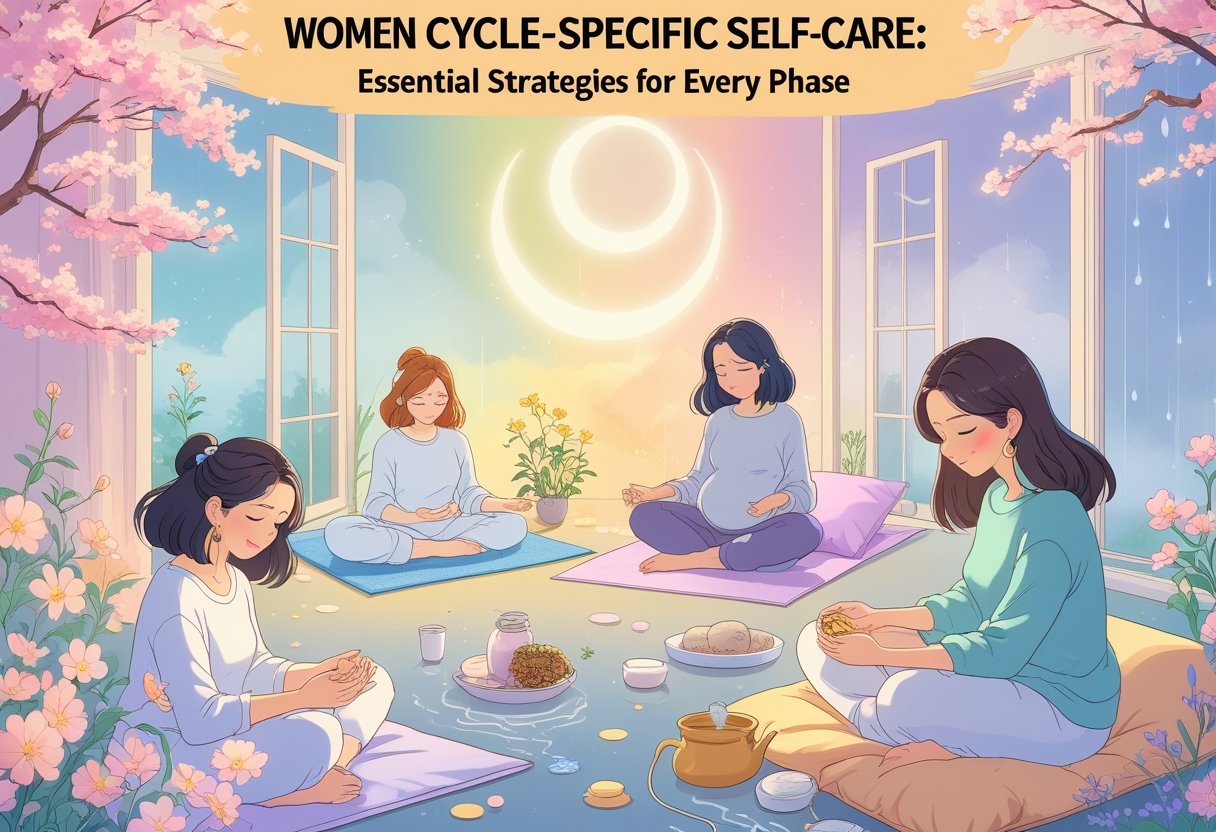Every woman's body moves through a natural monthly cycle, and these changes can affect energy levels, mood, and how she feels each day. Women who practice cycle-specific self-care can feel more balanced and comfortable by adjusting routines around each phase of the menstrual cycle. By understanding these patterns, it's possible to make choices that support physical and emotional health.

Cycle syncing is one way to do this, helping women match their diet, exercise, and self-care practices with the changing needs of their bodies throughout the month. Paying attention to these shifts can help reduce uncomfortable symptoms and improve overall well-being. To learn more about how to put this into action, read about cycle syncing and self-care in this guide to cycle syncing.
Key Takeaways
- Understanding your cycle helps you choose better self-care routines
- Customizing your diet and fitness plan can ease common symptoms
- Using helpful tools and tracking can support ongoing health
Understanding the Menstrual Cycle
The menstrual cycle repeats in about 28 days and is divided into four main phases. Hormones like estrogen and progesterone rise and fall, which can affect both physical symptoms and mental health.
The Four Phases Explained
The menstrual cycle has four phases: menstrual, follicular, ovulation, and luteal. The menstrual phase marks the start of bleeding and lasts about 3-7 days. Energy is often lower, and cramps may occur.
Next is the follicular phase, which lasts until ovulation. Estrogen levels begin to rise, and the body prepares to release an egg. This phase often brings a slow boost in mood and energy.
Ovulation comes in the middle, usually around day 14. The body releases an egg, and some may feel a slight cramp or notice clear discharge. Energy and confidence are usually highest.
After ovulation, the luteal phase begins. Progesterone rises. People may notice bloating, PMS symptoms, and lower energy as the body gets ready for the next cycle or for pregnancy. Learn more about these phases at Banner Health.
Hormonal Changes Throughout the Cycle
Hormones change a lot throughout these four phases. During the menstrual and follicular phases, estrogen levels start low but slowly climb, helping boost mood and energy. As the ovulation phase approaches, estrogen peaks.
At ovulation, the increase in estrogen helps to trigger the release of the egg. Right after, progesterone levels go up, especially during the luteal phase. Progesterone can cause the body to feel warmer and sometimes tired.
If pregnancy does not happen, both estrogen and progesterone drop. This shift is what causes the uterus to shed its lining during the menstrual phase, and many start to feel PMS symptoms as hormone levels drop. Health experts explain more about these changes at Healthline.
Common Symptoms and Mood Fluctuations
Many women have different symptoms at each stage of their menstrual cycles. Common physical symptoms include cramps, bloating, and headaches, especially in the menstrual and luteal phases. Some notice tender breasts or changes in appetite as hormones shift.
Mood also changes with hormone levels. Estrogen helps boost mood during the follicular and ovulation phases, often leading to higher energy and clearer thinking. In the luteal phase, before menstruation, people may experience PMS symptoms like irritability, sadness, or trouble sleeping.
A regular self-care routine, including rest, nutrition, and exercise adjustments, can help manage these shifts. Simple changes, like eating iron-rich foods or adjusting workouts, support the body and mind throughout the cycle as suggested by Health Matters NYP.
Cycle-Specific Nutrition and Diet
A woman’s nutrition needs can shift throughout the menstrual cycle due to hormone changes. Adjusting foods and nutrients during each phase can help support energy, mood, and reduce period symptoms.
Optimizing Nutrition for Each Phase
The menstrual cycle has four phases: menstrual, follicular, ovulation, and luteal. Each phase may need different foods for best results. During the menstrual phase, iron-rich foods like lean beef, lentils, and spinach can help replace iron lost in blood. It is also helpful to eat foods with vitamin C to increase iron absorption.
In the follicular phase, energy can rise, and the body may respond well to lean protein, whole grains, and fiber-rich foods. Around ovulation, a balanced diet with fruits, vegetables, and healthy fats is key to support hormone shifts. The luteal phase may bring lower energy and more cravings. Complex carbohydrates, such as sweet potatoes and oatmeal, may help to support energy levels and manage mood swings.
Many experts recommend aligning diet with cycle phases to help lessen cramps and promote overall wellness.
Managing Cravings and Sugar Intake
Cravings, especially for sugar or salty foods, often peak in the luteal phase, right before the period starts. This is a time when many women notice a drop in mood and energy. Swapping processed sugar for fruit, yogurt, or nuts can satisfy sweet cravings without spiking blood sugar. Choosing whole grain snacks, like popcorn or whole grain crackers, keeps energy more stable.
Some people also report increased caffeine cravings during this phase. Limiting caffeine can help reduce breast tenderness and improve sleep. Eating protein at each meal can help keep hunger and cravings steady.
Understanding these cycle-related cravings makes it easier to make healthier choices. Planning meals and snacks in advance may also help avoid reaching for high sugar options.
Essential Vitamins and Minerals
Certain vitamins and minerals play key roles during the cycle. Iron is important during menstruation to replace blood loss. Calcium and magnesium can help with mood swings, cramps, and water retention. Vitamin D is also important, supporting mood and immune function, but many people do not get enough from food alone.
Zinc and vitamin B6 can help support hormone balance and energy, especially during the luteal phase. A balanced diet with dairy, leafy greens, nuts, fish, and eggs provides most of these nutrients.
Some women may benefit from a multivitamin, but it is better to get nutrients from whole foods when possible. Learn more about cycle syncing and nutrition to find tips that fit individual needs.
Exercise and Fitness Strategies
Exercise plans can be adjusted throughout the menstrual cycle to help women feel their best. Paying attention to cycle syncing can improve energy, recovery, and motivation.
Tailoring Workouts to Your Cycle
Adapting exercise to the different phases of the menstrual cycle can help reduce discomfort and optimize performance. During menstruation, gentle activities like yoga and walking often feel better, while high-intensity routines may be tougher due to lower energy. Follicular phase workouts can include more strength and skill training as energy usually improves.
Mid-cycle, around ovulation, many experience a peak in energy and strength, making it a great time for challenging workouts such as sprinting, cycling, or skill-based sports. In the luteal phase, some may notice bloating or fatigue, so lighter routines and more recovery focus can help. Following a cycle syncing approach helps match exercise types to hormonal changes.
Tracking cycles in a journal or with an app allows for better planning and adjustment of exercise intensity and type. This personal approach often leads to fewer skipped workouts and a more balanced fitness routine.
Benefits of Strength Training
Strength training offers important benefits for women at all cycle stages. Lifting weights may help improve bone density, build muscle, and support metabolism. Some studies show that workouts focusing on strength may be better tolerated in the follicular and ovulatory phases.
Regular strength training may also reduce PMS symptoms like cramps, mood swings, and fatigue. Rest days or lighter weights during the late luteal and menstrual phases can support recovery and comfort.
Exercises like squats, lunges, push-ups, and deadlifts can be included throughout the month. Adjusting sets and reps to match how the body feels allows for continued progress and helps avoid overtraining.
Cardio and Pilates Integration
Cardio activities such as running, swimming, cycling, and dancing can boost heart health and increase energy. During the menstrual and luteal phases, lower-impact cardio or shorter sessions may feel better, while longer or more intense workouts can fit well mid-cycle. Different types of cardiovascular exercises, from brisk walking to group fitness classes, can be chosen based on mood and symptoms.
Pilates is a gentle full-body workout that can help build core strength and flexibility. It is often easier to tolerate when energy is low and can be used for injury prevention and stress relief during sensitive cycle days.
A mix of cardio and Pilates gives variety, supports fitness goals, and allows women to customize routines according to their cycle stage and daily needs.
Hormonal Balance and Self-Care Routines

Taking steps to keep hormones balanced often means looking for early signs of imbalance and developing steady self-care habits. The way a person eats, sleeps, and moves each day can support healthy hormone levels and lower stress.
Identifying Hormonal Imbalance
Hormonal imbalance can show up in many ways. Common signs include irregular periods, fatigue, mood swings, trouble sleeping, or sudden weight gain. Some women may also notice hair loss, acne, or changes in appetite.
It’s important to pay attention to these symptoms as they can affect both physical and mental health. Keeping track of symptoms in a journal or with a phone app can help spot patterns and triggers.
A doctor can check hormone levels through blood or saliva tests. If hormones are out of balance, they might recommend changes in lifestyle, nutrition, or treatment. Early recognition helps in getting the right care.
Everyday Self-Care Practices
Support for hormone balance starts with daily routines. Eating a balanced diet that includes protein, healthy fats, whole grains, and vegetables helps provide key nutrients. Drinking enough water and choosing whole foods over processed snacks can further promote steady energy.
Routine exercise, even walking or stretching, supports good blood flow and hormone health. Quality sleep, aiming for 7-9 hours each night, allows the body to repair and manage stress hormones like cortisol.
Mindful activities such as deep breathing, yoga, or journaling can lower anxiety and support the mind. Regular self-care protects mental health while helping to maintain steady hormone levels. Basic habits, done daily, build a healthy foundation.
Impact of Lifestyle Habits
Lifestyle choices play a big role in hormone regulation. High stress, poor sleep, and a diet high in sugar or processed foods can raise cortisol and trigger hormonal imbalance. Small changes such as setting a bedtime, reducing caffeine, or adding more vegetables can have a positive effect.
Women benefit from routines that respect the body’s natural rhythms, like cycle syncing, which involves matching nutrition and activity with menstrual cycle phases, as explained in detail on Baylor Scott & White Health’s blog. Limiting alcohol and tobacco also supports hormone balance.
Paying attention to how lifestyle habits affect mood, energy, and hormone levels can help guide positive changes. Consistent, thoughtful habits support well-being across the entire cycle.
Managing PMS, PMDD, and Menstrual Pain

Many women experience physical and emotional symptoms in the days leading up to their period. Learning what is normal, what helps, and when to get medical support makes it easier to manage PMS, PMDD, and menstrual pain.
Recognizing Pre-Menstrual Symptoms
Before a period starts, a woman may notice symptoms that signal the onset of PMS or PMDD. Common signs include bloating, headaches, tender breasts, mood swings, and trouble sleeping. Some may also feel more anxious or irritable than usual.
Mood changes can be mild or much stronger, making daily tasks harder. PMDD stands for premenstrual dysphoric disorder and is similar to PMS, but the mood symptoms are much more severe and disruptive. Tracking symptoms in a journal or app helps identify patterns each month and prepares women to manage regular cycles and sudden signs.
Effective Coping Strategies
Several lifestyle changes and habits can help manage PMS, PMDD, and menstrual pain. Eating a balanced diet with more protein and complex carbohydrates, while cutting back on sugar, salt, caffeine, and alcohol, can reduce many symptoms. Regular exercise often helps lower cramps and improves mood by releasing endorphins.
Stress management is important. Deep breathing, rest, and relaxation exercises can make mood swings and pain feel less overwhelming. Using a heating pad, taking warm baths, or gentle yoga stretches may relieve cramps. Tracking cycles is another useful step, as knowing when symptoms usually show up allows for better planning and self-care. For more detailed tips, visit Johns Hopkins’ page on PMDD self-care and diet changes.
When to Seek Medical Support
Medical help is important when symptoms stop a person from doing normal activities or cause major distress. If mood changes cause problems at work or in relationships, or if pain is too strong for over-the-counter medicine, it is time to talk to a doctor. PMDD often requires medicine, not just self-care, because symptoms can be disabling.
Doctors can recommend treatments such as hormone therapy, antidepressants, or pain relief methods. If someone notices new or very different symptoms, or if bleeding is much heavier than normal, a doctor should check for other issues. Early medical support can improve quality of life and prevent symptoms from getting worse. The Mayo Clinic provides clear advice on when to reach out for help with PMS and PMDD.
Cycle Tracking and Technology
Cycle tracking has become much easier and more accurate with the use of technology. Apps help women monitor their menstrual cycles, spot trends, and plan self-care around their health data.
Benefits of Using Period Tracking Apps
Period tracking apps let users record important information such as cycle start dates, symptoms, mood, and energy levels. By keeping track of these details, women can better predict when their period will start and understand patterns in their hormonal health. This helps with managing symptoms like cramps, bloating, or mood swings.
Apps often provide reminders for taking medication, staying hydrated, or tracking ovulation. This can be helpful for women who want to manage fertility or avoid surprises during their cycle. Many apps also offer privacy and allow users to export data to share with healthcare providers.
Studies have found these tools help users stay aware of their cycles and health needs. With accurate input, apps can also give helpful insights and predictions, making it easier for women to plan activities and self-care routines around their cycles. For more information, see how cycle syncing and tracking enhances self-care.
Popular Tools and Resources
Several apps have become popular for cycle tracking. Flo is well-known for its simple design and features like period prediction, ovulation tracking, and health tips. Clue is another top app, valued for its science-based approach and in-depth tracking options.
Other options include smartphone health ecosystems, such as Apple Health, which can pull together period tracking data with other health metrics. Some people use wearables, like the Oura Ring, to gather more detailed information about their bodies and cycles.
The table below compares two popular apps:
| App Name | Key Features | Unique Benefit |
|---|---|---|
| Flo | Cycle prediction, tips | Easy to use, health guides |
| Clue | Symptom tracking, charts | Science-based, custom data |
These resources make it easier for users to manage and understand their menstrual cycles using reliable, user-friendly tools. Learn more about how apps represent cycles in designs.
Frequently Asked Questions
Cycle-specific self-care involves choosing actions and habits that match each part of the menstrual cycle. Paying attention to nutrition, activity, comfort, and support can help improve daily life and physical health for many women.
What are the best self-care practices during menstruation?
Good self-care during menstruation includes using preferred sanitary products, changing them often, and keeping the vaginal area clean. Getting enough rest, drinking water, and using a heating pad can help manage cramps and fatigue. Lowering the room temperature may also provide comfort, as body temperature can rise during this time, according to women's health resources.
How can diet be optimized for different phases of the menstrual cycle?
Eating more iron-rich foods like lean meat or spinach helps replace lost nutrients during menstruation. In the follicular phase, foods with complex carbs and lean protein can boost energy. During the luteal phase, stable blood sugar is important, so regular meals with fiber and healthy fats help. Cycle syncing nutrition is explained further at cycle syncing and self-care.
What workouts are most beneficial throughout the menstrual cycle?
Gentle activities such as walking or yoga are helpful during menstruation due to lower energy. In the follicular phase, higher energy activities like cardio or strength training can be more comfortable. As energy drops in the luteal phase, lighter workouts and stretching may feel better. For more details, visit exercise and the menstrual cycle.
How can a partner provide support during a woman's period?
A partner can offer emotional support by listening and being patient. Helping with daily tasks, preparing warm drinks, or reminding her to rest can also make a big difference. Respecting her need for personal time is supportive as well.
What is cycle syncing and how can it enhance well-being?
Cycle syncing involves changing diet, exercise, and routines to match the body’s menstrual phases. This practice aims to reduce discomfort, balance energy, and promote better mental and physical health by anticipating and respecting natural changes. More information is available at cycle syncing and well-being.
What are effective ways to manage discomfort during ovulation?
Using over-the-counter pain relief or a warm compress can ease ovulation pain. Staying hydrated and practicing gentle movement like stretching or yoga may help reduce cramps. If pain is strong or does not go away, it’s important to talk to a healthcare provider.
Conclusion
Women who practice cycle-specific self-care often notice positive changes in their daily lives. Adjusting food choices, hydration, and exercise can help ease menstrual symptoms and improve well-being.
Listening to the body allows for better responses to hormonal changes. Using tools like journaling or cycle-tracking apps can make this process easier and more personal.
Cycle-specific self-care is not one-size-fits-all. Each person’s needs might change depending on their cycle phase. These phases may include:
- Menstrual: Rest and gentle movement
- Follicular: Increased activity and creativity
- Ovulatory: Social engagement
- Luteal: Relaxation and reflection
Focusing on self-care throughout the menstrual cycle supports both physical and mental health. Activities such as relaxation exercises and creating an open environment to talk about menstrual experiences help nurture well-being. For more specific guidance, consider reading about cycle syncing for nutrition and exercise.
Key self-care ideas:
| Area | Examples |
|---|---|
| Nutrition | Balanced meals, hydration |
| Physical well-being | Exercise, rest |
| Mental well-being | Meditation, journaling |
| Social support | Connecting with others |
Ongoing self-care and awareness help women navigate the different stages of their menstrual cycle with confidence.

